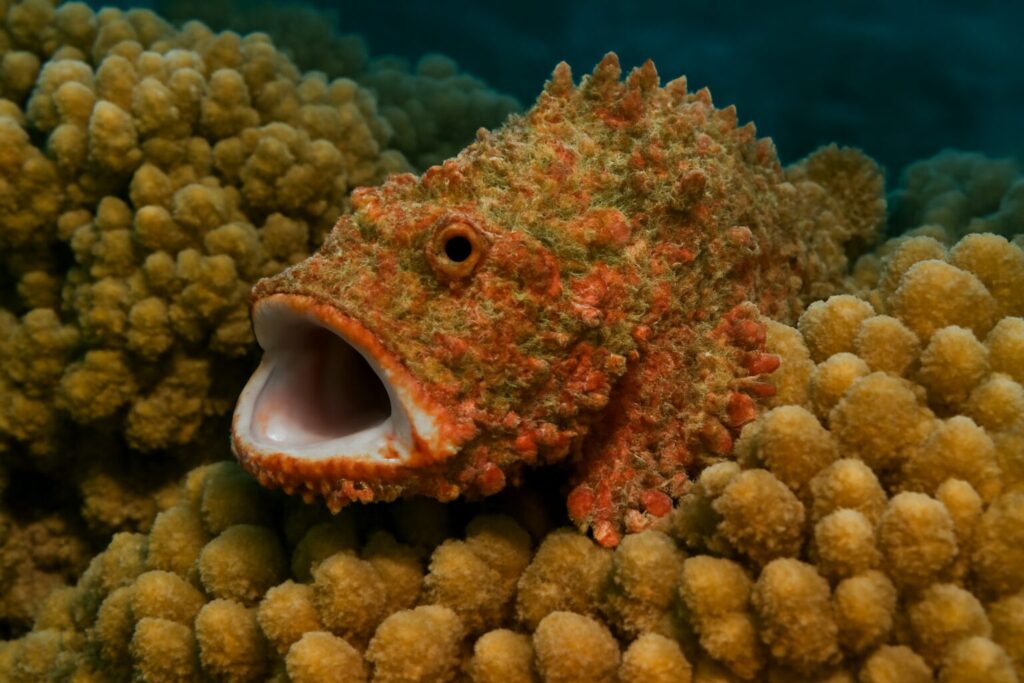In the Andaman Sea, teeming with diverse marine life, one of the most intriguing and unique creatures is the stonefish. Known as one of the most venomous fish in the world, the stonefish primarily inhabits coral reefs and rocky seabeds, making it difficult to spot. Its ability to blend seamlessly with its surroundings makes it a fascinating yet dangerous species. Beyond its stealth, the stonefish plays a crucial role in maintaining the ecological balance of the sea. However, encountering a stonefish is not without risk. If not handled with caution, its venom can pose a significant threat. Let’s dive deeper into the world of stonefish and learn how to stay safe from these remarkable yet hazardous creatures.

Table of Contents
Characteristics and Features of Stonefish
The stonefish is one of the most venomous fish in the world, scientifically known as Synanceia. What makes this fish truly remarkable is its exceptional ability to camouflage. Its body resembles a rock or coral, which allows it to blend perfectly with the environment, making it nearly invisible to divers and swimmers. Stonefish use this camouflage to hide from predators and prey alike.
Key characteristics of stonefish include:
- Size: Stonefish can grow up to 40 cm in length.
- Color: They come in a range of colors such as gray, brown, or yellowish-green, which help them blend into their environment.
- Fins: Their dorsal fin is covered with sharp spines that release venom when disturbed.
- Venom: The venom is potent enough to cause intense pain, swelling, and, in extreme cases, death if not treated promptly.
The Danger of Stonefish
Stonefish possess venomous spines located along their dorsal fin—13 spines in total. Each spine has a venomous sac underneath it, and when the spines are pressed, such as when stepped on or disturbed, venom is injected into the body.
The effects of stonefish venom include:
- Severe pain: The pain can be intense and immediately felt after contact.
- Swelling and redness: The affected area becomes swollen and inflamed.
- Shock and death: If not treated promptly, the venom can cause severe complications such as shock and even death.
Their excellent camouflage ability makes them hard to spot, increasing the risk of stepping on them accidentally.

Where to Find Stonefish in the Andaman Sea
Stonefish are often found in areas with sandy bottoms or rocky seafloors, where they can easily conceal themselves. Popular spots in the Andaman Sea, such as the Similan Islands and Surin Islands, are frequently visited by divers and snorkelers. These locations offer ideal environments for stonefish to hide in plain sight.
Hunting Strategy of the Stonefish
Unlike many fish that actively hunt for food, the stonefish relies on its camouflage to ambush prey. It remains still and waits for small fish or marine animals to swim too close. When the opportunity arises, it strikes quickly, opening its mouth to capture the unsuspecting prey.
The Ecological Importance of Stonefish
Stonefish play a crucial role in the marine ecosystem. By controlling the population of smaller marine creatures such as shrimp and small fish, they help maintain the balance of the food web. The hunting behavior of stonefish contributes to the health of coral reefs and ensures that smaller species do not overpopulate, which could disrupt the ecosystem.
Risks from Stonefish and How to Stay Safe
Although stonefish are highly venomous, encounters with them can be minimized with proper precautions. For those diving or snorkeling in the Andaman Sea or in areas where stonefish are present, it is essential to:
- Be cautious when walking on the seabed: Avoid stepping in areas with rocks that could potentially conceal a stonefish.
- Wear protective footwear: Diving shoes can help protect your feet from accidental stings.
- Seek medical attention immediately: If stung, it is crucial to seek medical help right away.
First Aid for Stonefish Stings
- Get the victim out of the water immediately and rinse the wound with seawater or clean water (do not squeeze the wound).
- Soak the wound in hot water (tolerable heat, 30-90 minutes) to reduce the effects of the venom.
- Seek medical attention immediately.
The Role of Conservation
Conserving stonefish in the Andaman Sea is crucial due to the increasing threats from environmental changes, such as coral reef destruction and illegal fishing practices. Protecting these creatures and their habitats ensures the survival of the stonefish and the overall health of the marine ecosystem.
Responsible marine tourism can also contribute to the conservation of these remarkable creatures and their environments, allowing future generations to study and appreciate the unique wildlife of the Andaman Sea.
Conclusion
Stonefish are not only masters of camouflage but also essential members of the marine ecosystem. Understanding their characteristics and behavior can help divers and swimmers remain safe while exploring the underwater world. By preserving the habitats of stonefish, we can ensure that these fascinating creatures continue to thrive in the Andaman Sea for years to come.
Contact Us
For more information on diving tours or questions about marine life, feel free to contact us:
Surin Islands Snorkeling Tour — Crystal-clear waters and shallow coral reefs ideal for observation.
Similan Islands Diving Tour — Dive into deeper waters and discover the hidden marine life.
Eco-Friendly Island Tours — Travel responsibly while preserving nature.
